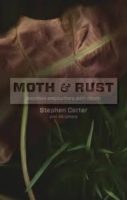Articles/Essays – Volume 51, No. 2
Not Alone | Stephen Carter, ed., Moth and Rust: Mormon Encounters with Death
Death is one of the great anxieties and mysteries that permeate human existence. Through various art forms, and across different contexts, people have sought to alleviate the sorrow and grief that stem from death. Moth and Rust: Mormon Encounters with Death is one such piece of art. In the opening pages of his introduction, editor Stephen Carter indicates that this text is not a “how-to guide to help you overcome grief ” (xi). Rather, it is “a sharing of raw emotion that may only add to your anxiety, but will remind you that you are not alone” (xi). The volume, comprised of a compilation of essays by authors such Devery Anderson, Steven L. Peck, Boyd J. Petersen, John Hatch, Lisa Torcasso Downing, Phyllis Barber, and Eugene England, lives up to this promise.
The contributions in this volume are organized into five sections: “Passages,” “Piercing the Veil,” “Fleeting,” “A Wider View,” and “A Single Soul.” The first gives particular attention to the passing of a loved one and the contributors’ heartfelt responses to these moments. “Piercing the Veil” offers insight into the soul after death, including visitations from departed family and insight into the continued presence of the deceased. The third section takes up death outside of the human experience of dying, offering accounts of the prevalence with death in the surrounding world. The final section presents individuals grappling with death and the way it manifests in the life of an individual. The contributions include personal narrative, poetry, and creative fiction.
The greatest strength of this compilation is its demonstration of the diversity of belief within Mormonism. The essays within the volume highlight complexity and the ways in which individuals from various backgrounds hold a variety of perspectives on death. In the introduction to the volume, Carter indicates that a book on encounters with death in a Mormon context should be boring because Mormonism figured out death and provides answers for the uncertainties of the hereafter. He writes, “We know that death is a veil separating our mortal sphere from the immortal sphere, and that when we cross to the other side there will be a potluck and relatives to greet us” (ix). However, the reality is much different. Although doctrines and insight from General Authorities abound in the Church, the lived understanding of death reflects the perspectives of each individual Mormon. It is often the case that these extend beyond simple narratives of the plan of salvation.
Illustrative of this strength are the essays by Paul Malan in “Passages” and Angela Hallstrom’s essay in “Piercing the Veil.” Malan’s essay, “Mormon Enough,” tells the story of his father’s stroke while serving a mission in Santo Domingo. Knowing his father’s wishes, Malan’s family asked doctors about removing life support. Unfortunately, this was an impossibility in the Dominican Republic. Turning to old emails from his father, Malan read through his father’s words, particularly an email exchange in which his father told him to “remember who you are.” It was these words that sparked Malan to succeed in bringing his father back to the US and removing life support, as his father would have wanted. Although inactive, Malan gave his father a blessing before he passed knowing he was “Mormon enough.” He writes, “But I am Mormon enough to bring him home to say goodbye to his Mormon family. I am Mormon enough to belong in that family. And that’s certainly Mormon enough for me” (12). In this short essay, Moth and Rust offers readers an account of a Mormon outside of an orthodox LDS paradigm who nevertheless identifies as Mormon and grapples with death in a meaningful and profoundly spiritual way.
A second essay that reflects the diversity within the volume is Angela Hallstrom’s “Visitations” found in the section titled “Piercing the Veil.” Within this essay, Hallstrom reflects on the visitations from women who have passed to the other side. These women come at particular times to minister, comfort, and protect. As she closes her description of the women who enter into the mortal realm at various points, she writes, “Mostly they are proud of you. How tough you are; how hard you try. They love you so much. That’s what they want to tell you most of all when they visit you in the night” (76–77). Through her narrative on the heavenly mothers that watch after their children, Hallstrom embodies the mission of the volume by sharing with her readers that they are not alone.
Each essay within this volume is worth acknowledgment for its profound impact. As I sat in my office and read through the accounts of sorrow, hope, grief, and love, I was met by the comfort of forty-six individuals who offered their story as a guiding light for life’s journey. I would recommend this volume to anyone, Mormon or otherwise, who seeks the knowledge that they are not alone.
Stephen Carter, ed. Moth and Rust: Mormon Encounters with Death. Salt Lake City: Signature Books, 2017. 257 pp. Paper: $23.95. ISBN: 9781560852650.


 Back to full Issue
Back to full Issue

